from Mechanix Illustrated, July, 1958
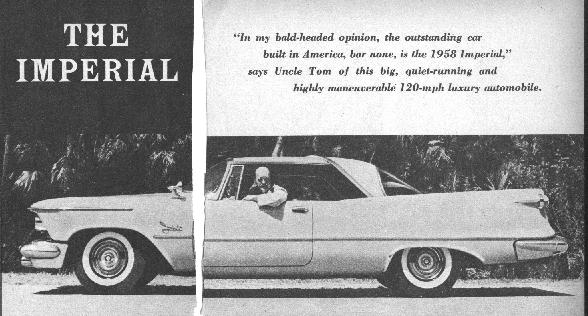
Tom McCahill Tests the 1958 Imperial
Click on thumb nails to get larger image

MODEL TESTED: Imperial Two-door Southampton
ENGINE: OHV V8 cyls; 392 cubic ins; 345 brake hp; 450 ft-lbs max torque; 10 to 1 compression ratio. Bore 4 ins; stroke 3.9 ins; Fuel required: Premium. Standard axle ratio: 2.93. Wheelbase 129 ins; lenghth 225.8 ins; width 81.2 ins; front tread 61.8 ins; rear tread 62.4 ins. Weight 4,590 lbs. Gas tank capacity 23 gals. Turning circle diameter 48.1 ft. Tire size 9.50 x 14.
PRICE (without options): $4,763.50
PERFORMANCE: 0 - 30 mph, 3.2 secs; 0 - 50 mph, 7.2 secs; 0 - 60 mph, 9.4 secs; 0 - 70 mph, 13 secs; 40 - 60 mph, 4.9 secs. Top speed 120 mph. All times recorded on corrected speedometer.
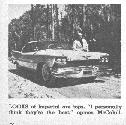 In Europe, the finer cars are under-going constant refinements to their basic designs. If you think all of Europe's first models are any more bug-free than ours, you're completely mistaken. Such top brands as Mercedes, Bentley and Rolls and similar classics experienced growing pains whenever new models were introduced. In this country, just about the time we have figured out why the trunk leaks, why the body squeaks, why the air-conditioning doesn't air-condition and a hundred other things, we scrap the whole design and start out all over again.
In Europe, the finer cars are under-going constant refinements to their basic designs. If you think all of Europe's first models are any more bug-free than ours, you're completely mistaken. Such top brands as Mercedes, Bentley and Rolls and similar classics experienced growing pains whenever new models were introduced. In this country, just about the time we have figured out why the trunk leaks, why the body squeaks, why the air-conditioning doesn't air-condition and a hundred other things, we scrap the whole design and start out all over again.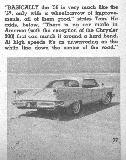 My test car was delivered to me in Florida by Brewster Shaw, the driving dealer who won the MI Acceleration Trophy again (for the fourth time) this year. It was a two-door Southampton model with all red leather upholstery. This costs only a few bucks more and looks to me like a thousand dollars more as I've never been a fan of combination fabric-and-imitation leathers. This is the real McCoy and the only upholstery to have in a car, for my dough
My test car was delivered to me in Florida by Brewster Shaw, the driving dealer who won the MI Acceleration Trophy again (for the fourth time) this year. It was a two-door Southampton model with all red leather upholstery. This costs only a few bucks more and looks to me like a thousand dollars more as I've never been a fan of combination fabric-and-imitation leathers. This is the real McCoy and the only upholstery to have in a car, for my dough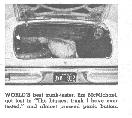 To test this car we took it deep into the Florida Everglades and the temperature on a deserted air strip we found was well over 110 degrees. Parked in the broiling sun on the airstrip (which is the acid test for any air-conditioner, since it has no forward rush of air to help the evaporators) I was able to get the inside cab temperature below 60 degrees and by playing with the thermostat it was easy to hold it at a more comfortable range, between 68 - 70 degrees. This is real air-conditioning and will prove a Godsend to anyone who must travel in 100 degree plus weather such as I do during mid-summer.
To test this car we took it deep into the Florida Everglades and the temperature on a deserted air strip we found was well over 110 degrees. Parked in the broiling sun on the airstrip (which is the acid test for any air-conditioner, since it has no forward rush of air to help the evaporators) I was able to get the inside cab temperature below 60 degrees and by playing with the thermostat it was easy to hold it at a more comfortable range, between 68 - 70 degrees. This is real air-conditioning and will prove a Godsend to anyone who must travel in 100 degree plus weather such as I do during mid-summer.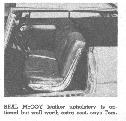 Stepping out of the car for a better appraisal of of the situation wasn't too comforting. I slipped the Imp into Low range and applied the gas as soft as a 30-second egg. When this didn't start me moving I threw caution to the winds, like the kid with the Seventh Veil, and clomped it. There were a couple of Voom! Vooms! and out we shot like a pebble from a slingshot. I feel sure that without the limited-slip feature we'd probably still be there, as no guy in his right mind ever came down that path.
Stepping out of the car for a better appraisal of of the situation wasn't too comforting. I slipped the Imp into Low range and applied the gas as soft as a 30-second egg. When this didn't start me moving I threw caution to the winds, like the kid with the Seventh Veil, and clomped it. There were a couple of Voom! Vooms! and out we shot like a pebble from a slingshot. I feel sure that without the limited-slip feature we'd probably still be there, as no guy in his right mind ever came down that path.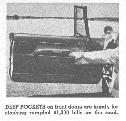 At high speeds (meaning well above 100 mph) it's as unwavering as the white line down the center of the road. We tried a number of emergency cuts, such as you might experience when some village dunce pulls out in front of you, and there was no breakaway. I've driven many sports cars that didn't handle half as well. We made a series of pictures of the car at an airport, taking a hard corner at better than 70 mph, but you won't see the pictures because this car corners so flat that there's absolutely nothing to show. Using an automatic Nikon camera that takes three pictures a second, the printed results of 36 photos of hard cornering look like a group of parked still shots.
At high speeds (meaning well above 100 mph) it's as unwavering as the white line down the center of the road. We tried a number of emergency cuts, such as you might experience when some village dunce pulls out in front of you, and there was no breakaway. I've driven many sports cars that didn't handle half as well. We made a series of pictures of the car at an airport, taking a hard corner at better than 70 mph, but you won't see the pictures because this car corners so flat that there's absolutely nothing to show. Using an automatic Nikon camera that takes three pictures a second, the printed results of 36 photos of hard cornering look like a group of parked still shots. One new feature which is extra equipment and was on my test car is Chrysler's 1958 Auto Pilot. In many ways this resembles the automatic governor on the old Silver Ghost Roll-Royce back in the days around World War I. I owned a number of Rolls and took advantage of this feature in hundreds of miles of cross-country travel. With the old Rolls, which had a now-forgotten gas throttle on the steering column, once in high gear, you could set the notched hand throttle for, let's say, 50 mph and from that point on you'd go 50 mph - uphill, downhill and around corners. It had one drawback that Chrysler's new gizmo doesn't - you kept on going at this speed even though the Twentieth Century Limited might cross your path, until you slapped the throttle down. As all but the last model Silver Ghost had two-wheel brakes, stepping on the brakes had about as much effect as slowing down the Queen Mary by dragging your foot.
One new feature which is extra equipment and was on my test car is Chrysler's 1958 Auto Pilot. In many ways this resembles the automatic governor on the old Silver Ghost Roll-Royce back in the days around World War I. I owned a number of Rolls and took advantage of this feature in hundreds of miles of cross-country travel. With the old Rolls, which had a now-forgotten gas throttle on the steering column, once in high gear, you could set the notched hand throttle for, let's say, 50 mph and from that point on you'd go 50 mph - uphill, downhill and around corners. It had one drawback that Chrysler's new gizmo doesn't - you kept on going at this speed even though the Twentieth Century Limited might cross your path, until you slapped the throttle down. As all but the last model Silver Ghost had two-wheel brakes, stepping on the brakes had about as much effect as slowing down the Queen Mary by dragging your foot.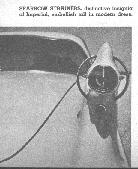 If you wish to lower or raise speed without calling off the Auto Pilot you can turn the speed dial down to 30 mph and the car will come down to that speed and hold a steady 30 mph. Or you can shove it all the way up to "9" (which is 90 mph) and you'll be doing 90 mph. While you're doing it you can have your feet parked in the glove compartment, if that's the way you like to drive. Below 30 mph and above 90 mph, however, you'll have to resort to the old-fashioned methods and do it the hard way by pushing your foot down on the gas pedal. For an extra burst of speed, floor the accelerator and when you remove your foot the car will return to the pre-set speed automatically.
If you wish to lower or raise speed without calling off the Auto Pilot you can turn the speed dial down to 30 mph and the car will come down to that speed and hold a steady 30 mph. Or you can shove it all the way up to "9" (which is 90 mph) and you'll be doing 90 mph. While you're doing it you can have your feet parked in the glove compartment, if that's the way you like to drive. Below 30 mph and above 90 mph, however, you'll have to resort to the old-fashioned methods and do it the hard way by pushing your foot down on the gas pedal. For an extra burst of speed, floor the accelerator and when you remove your foot the car will return to the pre-set speed automatically. In summing up, here are a few of the features which make this car so outstanding: First, few will deny its looks (I personally think they're the best). But the car is no boulevard dandy; it is just as much at home on any road in America as any car built. For '58 it has anew turn indicator switch which is great (last year's was a horror) and in each front door there are deep door pockets.* The mammoth trunk (mcMichael reports it is the biggest he's tested) is lined with deep carpeting to keep your luggage from being chewed up. The brakes are tops and evn the damnable side mirror can now be adjusted from the inside.* The car will top 120 mph: do 0 - 60 in under 10 seconds and is as quiet as Gimbel's basement on Chritmas morn. In four words - It's America's Finest Car.
In summing up, here are a few of the features which make this car so outstanding: First, few will deny its looks (I personally think they're the best). But the car is no boulevard dandy; it is just as much at home on any road in America as any car built. For '58 it has anew turn indicator switch which is great (last year's was a horror) and in each front door there are deep door pockets.* The mammoth trunk (mcMichael reports it is the biggest he's tested) is lined with deep carpeting to keep your luggage from being chewed up. The brakes are tops and evn the damnable side mirror can now be adjusted from the inside.* The car will top 120 mph: do 0 - 60 in under 10 seconds and is as quiet as Gimbel's basement on Chritmas morn. In four words - It's America's Finest Car.•Site Entry•
•Dimensions, Statistics, Facts and Figures•
•The Imperial: A Brief History•
•My story, Part 1. From my first to my current owner•
•My story, Part 2. From 1994 to 1998•
•My story, Part 3. From 1998 to the present•
•Cracked head woes in 2001•
•Photo album•
•Tom McCahill's 'Mechanix Illustrated' 1958 Imperial Review;
•Other 1958 Imperials•
•Other 1958 Cars•
•1958 Imperial Advertising images•
•News & Trivia from 1958•
•Mecnaical Info: Parts, Suppliers•
•Imperial Links - Web Sites, Books, Videos, Etc•
•Family & Friends•
•Contacting Mrs. Blueberry•